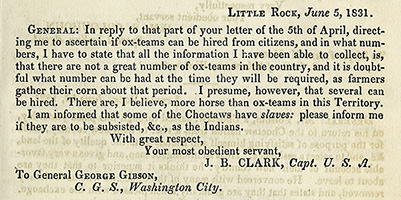Removing Indians from the American South did not happen suddenly, quickly, or in secret. The act was the result of a national debate that began decades earlier. Led by President Andrew Jackson, those in favor saw Indian nations as an obstacle to economic development and a threat to national security. Opponents, including Native leaders, argued that the act went against democratic values. Ultimately removal presented a moral test to the new nation. Could the United States stay true to its ideals? Could it bring prosperity to the South and also treat American Indians with justice and respect? The nation tried to accomplish both goals. It succeeded at only one.
Implementing the Indian Removal Act was an unprecedented national project. For all the chaos, record keeping was well organized.
Entire Indian nations were to be exiled west of the Mississippi, outside the settled borders of the United States.

Removal produced reams of directives, memos, receipts, and other paperwork.

Travel expenses were carefully examined and corrected to the penny. The tone in letters and memos was consistently professional.

Today we remember removal as a tragedy. True enough. But it was also part of a massive, nationwide transformation. In creating wealth, the law was a spectacular success. The American South became the Cotton Kingdom and United States a global economic powerhouse. Soon Mississippi and Alabama had more millionaires per capita than any other states. That wealth was generated by the enslavement of millions, which led to the Civil War.
Removal was epic in scale, ambition, cost, and impact.What was supposed to be a relatively quick and manageable project spanned nine U.S. presidencies and cost more than 40 times the amount originally estimated. In 1837 and 1838, removal constituted a full 20 percent of the federal budget. The boom enriched contractors, who provided cattle, pork, coffee, sugar, corn, flour, salt, wagons, teamsters, pack horses, boats, ferrymen, road builders, rifles, and ammunition.
Removal was also brutal, and a catastrophe for Indians. Poor planning, incompetence, bad weather, and unforeseen circumstances contributed to extraordinary suffering. About 68,000 Native people were exiled from their southeastern homelands. Even after they rebuilt in Oklahoma, Indian nations endured devastating assaults on their rights of self-government. Against all odds they are thriving today.